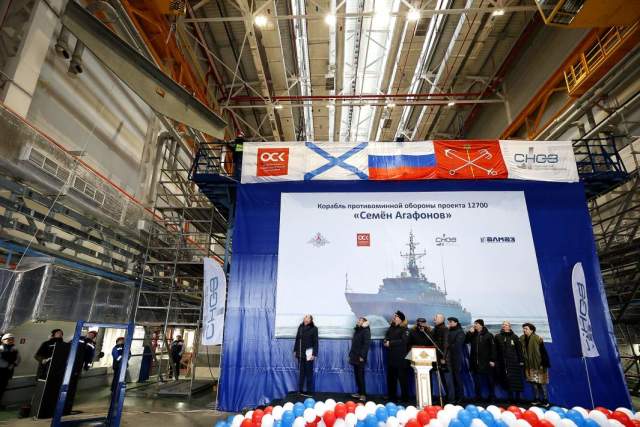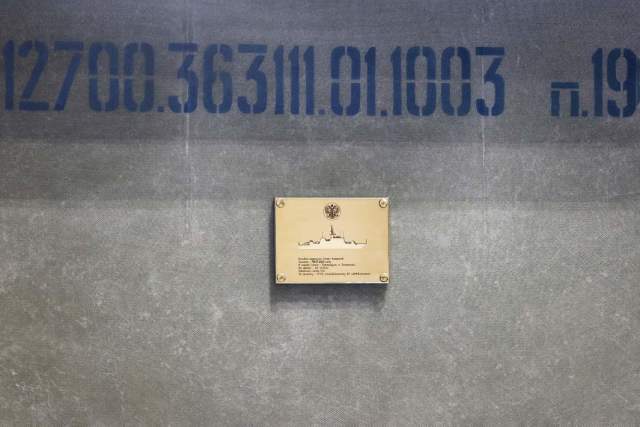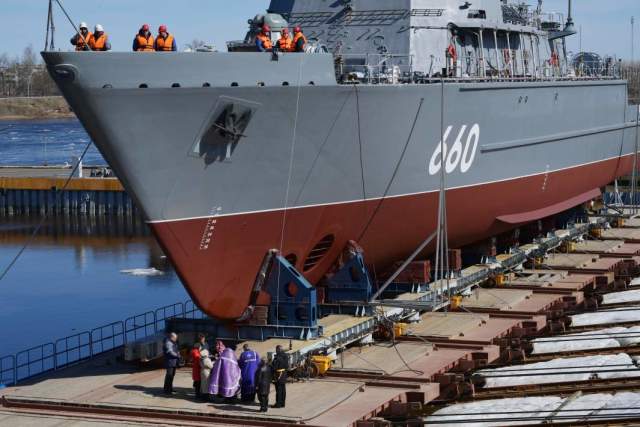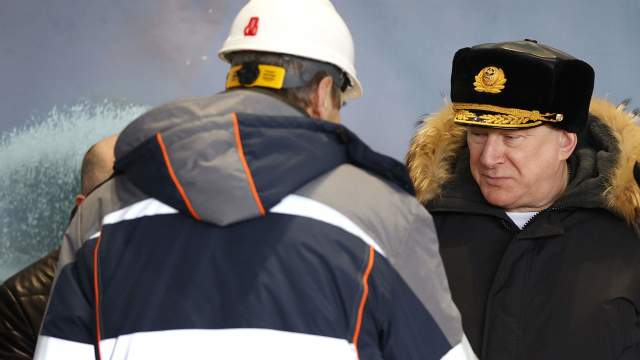A new ship of the 12700 project was laid in St. Petersburg, which cleans the seas with the help of robots
The minesweeper Semyon Agafonov of the 12700 Alexandrite project, laid down on January 18 in St. Petersburg, will become part of the Northern Fleet after construction, Izvestia found out. To search for and destroy mines, this series of ships uses light boats with special underwater robots. The hull of the minesweeper will be made entirely of fiberglass. In the Northern Fleet, Semyon Agafonov will ensure the deployment of ships and nuclear submarines, experts believe. The commander-in-chief of the Navy, Nikolai Evmenov, said that no fleet in the world, except the Russian one, has combat units like the ships of the 12700 project, and there will be many more orders for their construction.
The Navy needs them
On Thursday, January 18, the laying of the next mine defense ship of the 12700 Alexandrite project took place at the Sredne-Nevsky Shipyard in St. Petersburg. Such minesweepers are "workers of the sea" and there are always not enough of them, Admiral Nikolai Evmenov, Commander—in-chief of the Navy, said at the ceremony.
— The series of these ships has shown its usefulness for the Navy, confirmed all the technical characteristics laid down in it by the designers. No one in the world makes such ships, except the Sredne-Nevsky shipyard. This ship is unique, as the whole series is unique," the admiral noted.

Commander-in-Chief of the Navy, Admiral Nikolai Evmenov at the laying ceremony of the minesweeper Semyon Agafonov
Image source: Photo: IZVESTIA/Vladimir Blank
According to Evmenov, there will be many more orders for the construction of these ships, "the fleet needs them."
The head of the All-Russian Fleet Support Movement, Captain 1st rank Vladimir Maltsev, said that the Semyon Agafonov would presumably become part of the Northern Fleet. There he will be engaged in ensuring the deployment of nuclear submarines and warships, military expert Dmitry Boltenkov told Izvestia.
— This is the most modern minesweeper, which is being built in series, — he noted. — It does not have a magnetic hull, it is well equipped with various trawls, search and mine detection tools. It's a very good project. This ship is the 12th in a row. This means that we are systematically updating the mine action forces, now there are eight units in service, four are under construction.
The ship is completely made of fiberglass by the diffusion method, military expert, Captain 1st rank Vasily Dandykin told Izvestia.

Photo: IZVESTIA/Vladimir Blank
Image source: iz.ru
— Until quite recently, our trawling forces were mainly Soviet. Their service life is ending, they are being replaced by modern ships Project 12700 Alexandrite. Now this is our main mine—fighting ship," he explained. — It is extremely necessary to continue producing the series, in particular due to the fact that Ukraine is dabbling in the Black Sea. And in general, if the fleet is operating, minesweepers should go first, which remove mines of various properties, and then warships.
The ship, laid down on January 18, will be the 12th in the series. To date, eight Project 12700 minesweepers are in service. Three of them serve in the Black Sea, three in the Pacific Ocean and two in the Baltic. The last representative of the series at the moment, Lev Chernavin, was transferred to the fleet on December 25 last year, along with the frigate Admiral Golovko and the small missile ship Naro-Fominsk. President Vladimir Putin took part in the flag-raising ceremony. The Head of State noted then that, in accordance with the naval doctrine, work continues on serial production and planned deliveries of modern ships to the Navy.
On January 3, the Russian Defense Ministry announced that one of the first this year's fleet will include the small missile ship Burya and the submarine Kronstadt, which underwent a test program in the Baltic Sea in 2023. It was also noted that the Pacific, Baltic and Black Sea fleets will be strengthened by several small missile and patrol ships, as well as naval minesweepers. In addition, the naval flag will be raised on the nuclear-powered submarine missile cruiser Arkhangelsk of the Yasen-M project, designed for the submarine forces of the Northern Fleet. This will happen when the ship completes the state tests.
The solemn ceremony of launching the mine defense ship project 12700 "Lev Chernavin"
Image source: Photo: RIA Novosti/Alexander Galperin
In memory of the Hero
The laid-down minesweeper was decided to be named after the Hero of the Soviet Union, Semyon Agafonov. He is a famous marine, a scout, a participant in the Great Patriotic War and the Soviet-Japanese Wars. He made 50 campaigns and landings behind enemy lines. He received the Hero's Star for his participation in the Petsamo-Kirkenes offensive in 1944. The task was to capture the German battery at Cape Krestovy in order to allow our landing party to pass. Having captured the positions, the scouts repelled the enemy's counterattacks for three days, holding out until the main forces approached.
The most famous combat episode involving Semyon Agafonov occurred in August 1945, when a dozen Soviet sailors captured three thousand Japanese garrison. During the negotiations, Japanese officers wanted to take Soviet soldiers hostage, but they locked the room, and Semyon Agafonov began throwing a grenade in his hand. As a result, the Japanese command surrendered.

Hero of the Soviet Union Semyon Agafonov
Image Source: Photo: commonswikimedia.org
Robots are looking for mines
The minesweepers of the 12700 Alexandrite project have a unique fiberglass hull, which does not react to magnetic ammunition fuses. The ship can reach a speed of about 16 knots, its displacement is approximately 890 tons, and the crew is 44 people.
The Diamant system, which includes two light boats with special underwater robots, is installed on board to search for and destroy mines. It is designed to neutralize obstacles within 10 km and at a depth of up to 100 m. Due to the plastic hull and low-noise engine, sea mines do not react to the boats, they can search using sonar and magnetometers.
The Alexandrite-ISPUM integrated mine search and destruction system is responsible for the detection of deep-sea objects. It consists of a remote—controlled underwater vehicle capable of detecting suspicious objects within a radius of 500 m and at a depth of up to 300 m, moving at a speed of 3-6 m/s. The equipment can work underwater with sea waves up to three points.

The solemn ceremony of launching the mine defense ship project 12700 "Lev Chernavin"
Image source: Photo: RIA Novosti/Alexander Galperin
When dangerous finds are discovered, underwater drones are used, which install explosive charges on them. They can also tow the ammunition into shallow water and destroy it there. Remote mine clearance tactics minimize the risk to personnel. Patrol ships of the 22160 project interact well with minesweepers, which were specially designed to protect ships during sea crossings and protect naval bases.
Roman Kretsul

